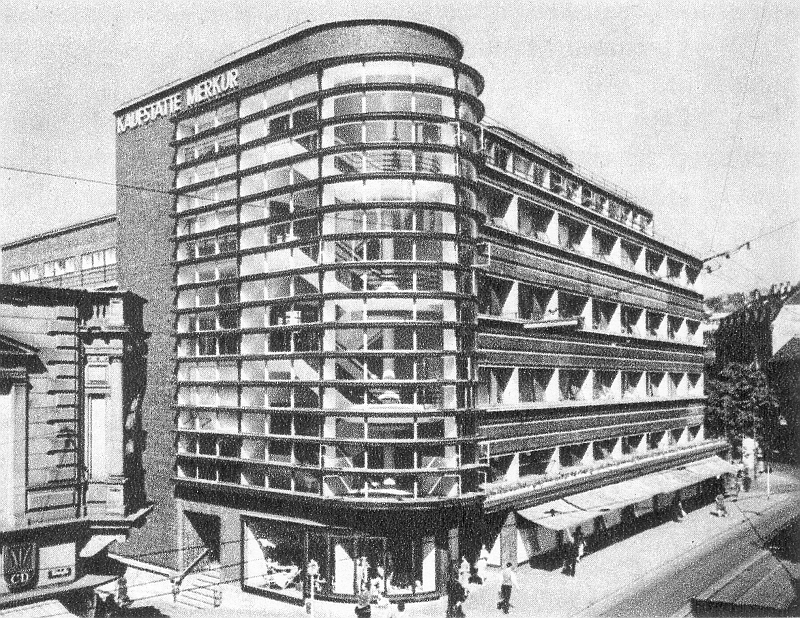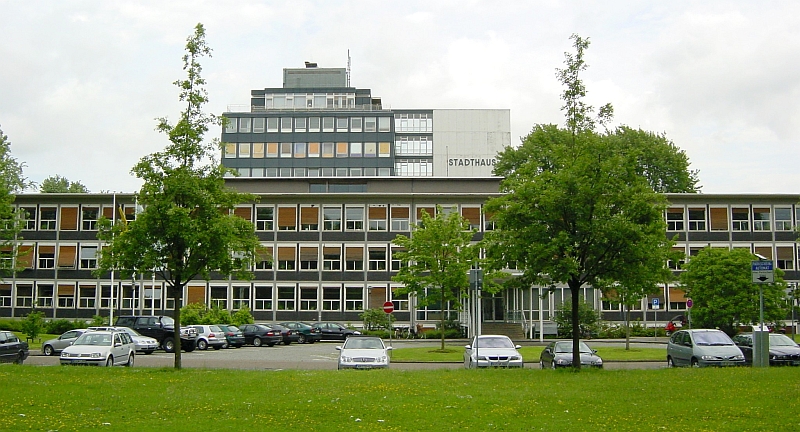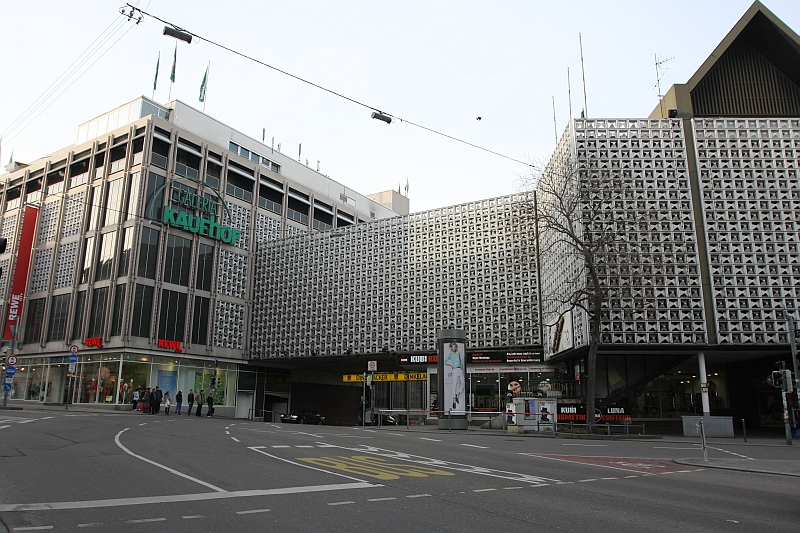On Egon Eiermann and the maintenance of his legacy……
In the context of another project we are currently researching various aspects of Egon Eiermann‘s architectural output.
And have discovered the most wonderful contradictory positions as regards dealing with his legacy.
Contradictory positions which pose the more general question as to how one should approach modernist architectural legacies.
Should all works be saved? Are all buildings really worth saving? Are there alternatives?
In Stuttgart Egon Eiermann’s IBM Campus is under threat of demolition. Constructed from 1967 to 1972 the sprawling campus has remained empty since IBM moved out in 2009; and the new owner, having failed to find any new tenants or alternative uses, went bankrupt in 2011. With no interested parties in sight, and, according to the Stuttgarter Zeitung, the necessary renovations potentially costing around 100 million Euros1, the administrator has applied to have the buildings demolished so that the site can be sold for new development.
In Krefeld meanwhile the city authority recently decided to invest around Euro 40 Million in the renovation of Eiermann’s 1953 Stadthaus rather than build a new city hall. Among the reasons given by Oberbürgermeister Gregor Kathstede was that Krefeld was/is applying to be a UNESCO World Culture Heritage Site on the basis of three Mies van der Rohe buildings, and to simultaneously leave an Egon Eiermann building to rot or even pull it down would be unjustifiable.2
But does it matter who was responsible for a building? And should one even have sympathy with an architect such as Egon Eiermann?
Aside from being the opinion that one should tear down the remains of the Kaiser-Wilhelm-Gedächtniskirche in Berlin to make way for the new church – plans Eiermann had to abandon due to the level of protest in Berlin – Egon Eiermann did tear down Erich Mendelsohn’s universally admired Schocken department store in Stuttgart in order to build his own Horten department store.
A decision that attracted international criticism and even moved Walter Gropius to protest.
Defending his decision Eiermann claimed Mendelsohn’s building was “substandard” and that the building generally wasn’t fit for its function.3
Somewhat amusingly in discussing the Stadthaus in Krefeld Martin Linne, head of the city’s planning department, told the Rheinische Post “Eiermann had the idea that the heating in the roof should heat in the winter and cool in the summer…. The problem is: his technology has never worked properly”4
A situation that will sound familiar to any one who has ever worked in a prize winning building in Leipzig’s hip Lower East Plagwitz Village.
Could/should one therefore not apply the “good for the goose: good for the gander” test and tear down Eiermann’s “substandard” Stadthaus?

Schocken (later Merkur) Department Store in Stuttgart by Erich Mendelsohn (Image Source: Wikimedia Commons)
Referring to the planned demolition of the Schocken department store Erich Mendelsohn’s widow is quoted as saying “Later generations will be much better placed to asses Erich Mendelsohn’s importance in the development of 20th century architecture – and so we condemn that one of his few remaining works should be voluntarily executed by his countrymen”5
That later generations are better placed to decide on the importance of any cultural good is, we believe, an indisputable fact. But does one actually need the building to achieve such?
When dealing with architects of yore the answer is potentially yes, because all to often we lack the documentation to be able to otherwise assess the work.
However the works of an Egon Eiermann, or indeed an Erich Mendelsohn, are not only well documented in the architects own archives, but we have the reports, interviews and discussions that surrounded the planning and construction.
The building is then just the physical manifestation of the process.
We don’t believe every building is automatically worth keeping, just because it is from architect X or Y.
Where a building is no longer required or is no longer capable of fulfilling its intended function, it must make way for a construction that can.
Which of course doesn’t mean automatically tearing down old buildings. As a first step must surely come the question if one can’t make alterations. Adapt the building to its new function and/or new technological standards.
On the one hand there are ecological considerations, justifications, in tearing down an existing building and raising a new one.
There there are the costs.
One of the current stars on the international architecture exhibition circuit is the Tour Bois le Prêtre high-rise block in Paris. Earmarked by the city authority for demolition the architects Druot, Lacaton & Vassal proposed instead a “living renovation” of the block. A renovation which has not only improved the standard of life of the residents and greatly reduced their energy usage, but has done so at a fraction of the cost associated with demolition and building anew.
Similarly, in addition to the considerations involving Mies van der Rohe, according to Oberbürgermeister Kathstede building a new town hall in Krefeld would have cost some Euro 20 million more than renovating Eiermann’s building.6
A further excellent example of such considerations in the context of Egon Eiermann’s legacy can be found just across the Rhein from Krefeld.
The A3 motorway in Duisburg is spanned by a bridge – a bridge designed by Egon Eiermann as part of his German Pavilion for the 1958 Brussels Expo.
Following the Expo the bridge came to Duisburg and for the past 54 years has linked the two halves of Duisburg Zoo.
According to the Westdeutsche Allgemeine Zeitung, WAZ, when the motorway need widening from 4 to 6 lanes rather than simply scrap the bridge the responsible planners extended it a bit so that it fitted its new purpose.7
Simple decisions that save resources, save money and, for us, continue the constructions legacy better than simply maintaining the bridge as it was where it was.
The context of the bridge’s use has changed. Why shouldn’t the bridge itself also change?
Form famously following function.
Similarly the Stadthaus in Krefeld was originally built as the headquarters of Vereinigten Seidenwerke and has only been used by the council since the late 1970s.
New context. New function. Why not new form?
Which of course in terms of the IBM Campus means one could relax the planning regulations in terms of the interior and technical considerations so that the buildings can be used in a new context.
Saves resources, saves money and, for us, continues the ….
Decisions to keep or demolish buildings are largely emotional. But they shouldn’t be.
There can be very good reasons to preserve buildings that have a particular importance, but such decisions must be made in a sober, cases-by-case way.
And we shouldn’t have so much fear of changing buildings. Change is after all what keeps us all fresh, helps society evolve and develop. Is what made architects such as Egon Eiermann so important.
The three examples above of Egon Eiermann’s work highlight the problems involved in dealing with the legacies of modernist architects. And also make clear that in the coming years there will be an awful lot of similar decisions to be made in relation to an awful lot more modernist buildings.
And so now is perhaps a good time for all involved to decide what is truly important.
Just a thought….
1.http://www.stuttgarter-zeitung.de/inhalt.kulturdenkmal-der-alten-ibm-zentrale-droht-der-abriss.4c6dc2b4-0660-4200-b930-b10a7134205f.html Accessed 30.04.2013
2.http://www.krefeld.de/C1257455004E4FBF/html/1B42165B3F003134C1257944005909D6?opendocument Accessed 30.04.2013
3.http://www.spiegel.de/spiegel/print/d-42622632.html Accessed 30.04.2013
4.http://www.rp-online.de/niederrhein-sued/krefeld/nachrichten/stadthaus-wird-ein-aha-erlebnis-1.2757924 Accessed 30.04.2013
5.http://www.spiegel.de/spiegel/print/d-42622632.html Accessed 30.04.2013
6.http://www.krefeld.de/C1257455004E4FBF/html/1B42165B3F003134C1257944005909D6?opendocument Accessed 30.04.2013
7.http://www.derwesten.de/staedte/duisburg/expo-bruecke-zog-von-bruessel-nach-duissern-nach-neudorf-id7881543.html Accessed 30.04.2013
Tagged with: Egon Eiermann, Stuttgart

